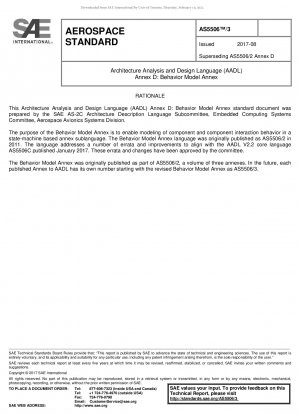SAE AS5506/3-2017
Architecture Analysis and Design Language (AADL) Annex D: Behavior Model Annex
- Standard No.
- SAE AS5506/3-2017
- Release Date
- 2017
- Published By
- SAE - SAE International
- Latest
- SAE AS5506/3-2017
- Scope
- INTRODUCTION The SAE Architecture Analysis and Design Language (referred to in this document as AADL) is a textual and graphical language used to design and analyze the software and hardware architecture of performance-critical realtime systems. These are systems whose operation strongly depends on meeting non-functional system requirements such as reliability@ availability@ timing@ responsiveness@ throughput@ safety@ and security. AADL is used to describe the structure of such systems as an assembly of software components mapped onto an execution platform. It can be used to describe functional interfaces to components (such as data inputs and outputs) and performance-critical aspects of components (such as timing). AADL can also be used to describe how components interact@ such as how data inputs and outputs are connected or how application software components are allocated to execution platform components. The language can also be used to describe the dynamic behavior of the runtime architecture by providing support to model operational modes and mode transitions. The language is designed to be extensible to accommodate analyses of the runtime architectures that the core language does not completely support. Extensions can take the form of new properties and analysis specific notations that can be associated with components and are standardized themselves. AADL was developed to meet the special needs of performance-critical real-time systems@ including embedded real-time systems such as avionics@ automotive electronics@ or robotics systems. The language can describe important performance-critical aspects such as timing requirements@ fault and error behaviors@ time and space partitioning@ and safety and certification properties. Such a description allows a system designer to perform analyses of the composed components and systems such as system schedulability@ sizing analysis@ and safety analysis. From these analyses@ the designer can evaluate architectural tradeoffs and changes. AADL supports analysis of cross cutting impact of change in the architecture along multiple analysis dimensions in a consistent manner. Consistency is achieved through automatic generation of analysis models from the annotated architecture model. AADL is designed to be used with generation tools that support the automatic generation of the source code needed to integrate the system components and build a system executive from validated models. This architecture-centric approach to model-based engineering permits incremental validation and verification of system models against requirements and implementations against systems models throughout the development lifecycle. This document contains a revised version of the Behavior Annex@ that enables modeling of component and component interaction behavior in a state-machine based annex sublanguage.
SAE AS5506/3-2017 history
- 2017 SAE AS5506/3-2017 Architecture Analysis and Design Language (AADL) Annex D: Behavior Model Annex

SAE AS5506/3-2017 -All Parts
SAE AS5506-2004 ARCHITECTURE ANALYSIS & DESIGN LANGUAGE (AADL)
SAE AS5506/1-2011 SAE Architecture Analysis and Design Language (AADL) Annex Volume 1:Annex A: Graphical AADL Notation,Annex C: AADL Meta-Model and Interchange Formats,Annex D: Language Compliance and Application Program InterfaceAnnex E: Error Model Annex
SAE AS5506/1A-2015 SAE Architecture Analysis and Design Language (AADL) Annex Volume 1: Annex A: ARINC653 Annex, Annex C: Code Generation Annex, Annex E: Error Model Annex
SAE AS5506/2-2019 SAE Architecture Analysis and Design Language (AADL) Annex Volume 2:Annex B: Data Modeling AnnexAnnex D: Behavior Model AnnexAnnex F: ARINC653 Annex
SAE AS5506/3-2017 Architecture Analysis and Design Language (AADL) Annex D: Behavior Model Annex
SAE AS5506/4-2019 Architecture Analysis & Design Language (AADL) Annex F: AADL Annex for the FACETM Technical Standard Edition 3.0
SAE AS5506A-2009 Architecture Analysis & Design Language (AADL)
SAE AS5506B-2012 Architecture Analysis & Design Language (AADL)
SAE AS5506C-2017 Architecture Analysis & Design Language (AADL)
SAE AS5506D-2022 Architecture Analysis & Design Language (AADL)